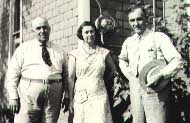Electricity was common in U.S. cities in the early 1930s, but the countryside was left in the dark. Almost everyone in rural areas was a farmer. They had to pump water by hand; light came from coal oil lamps. Wood or coal stoves heated homes, dish water and food. It was indeed a labor-intensive life.
Despite farmers' pleas, privately owned power companies said serving rural areas would be too costly because the houses were too far apart and farmers would not use much electricity.
Then the Rural Electrification Administration was formed in 1935 to administer a program to encourage rural electrification and to lend low-interest money to any group or company that would undertake the task. Even with the offer of low-interest financing, private companies still would not get involved. Instead, farmers formed cooperatives to do the job themselves.
In this area, organizers started a drive to get electricity in 1937. Hancock-Wood was founded April 20, 1938, and the first lines were electrified in 1939.
Since then, the co-op has grown and membership has become quite diverse. We serve members in 10 counties, spanning across 1,800 miles of line.


